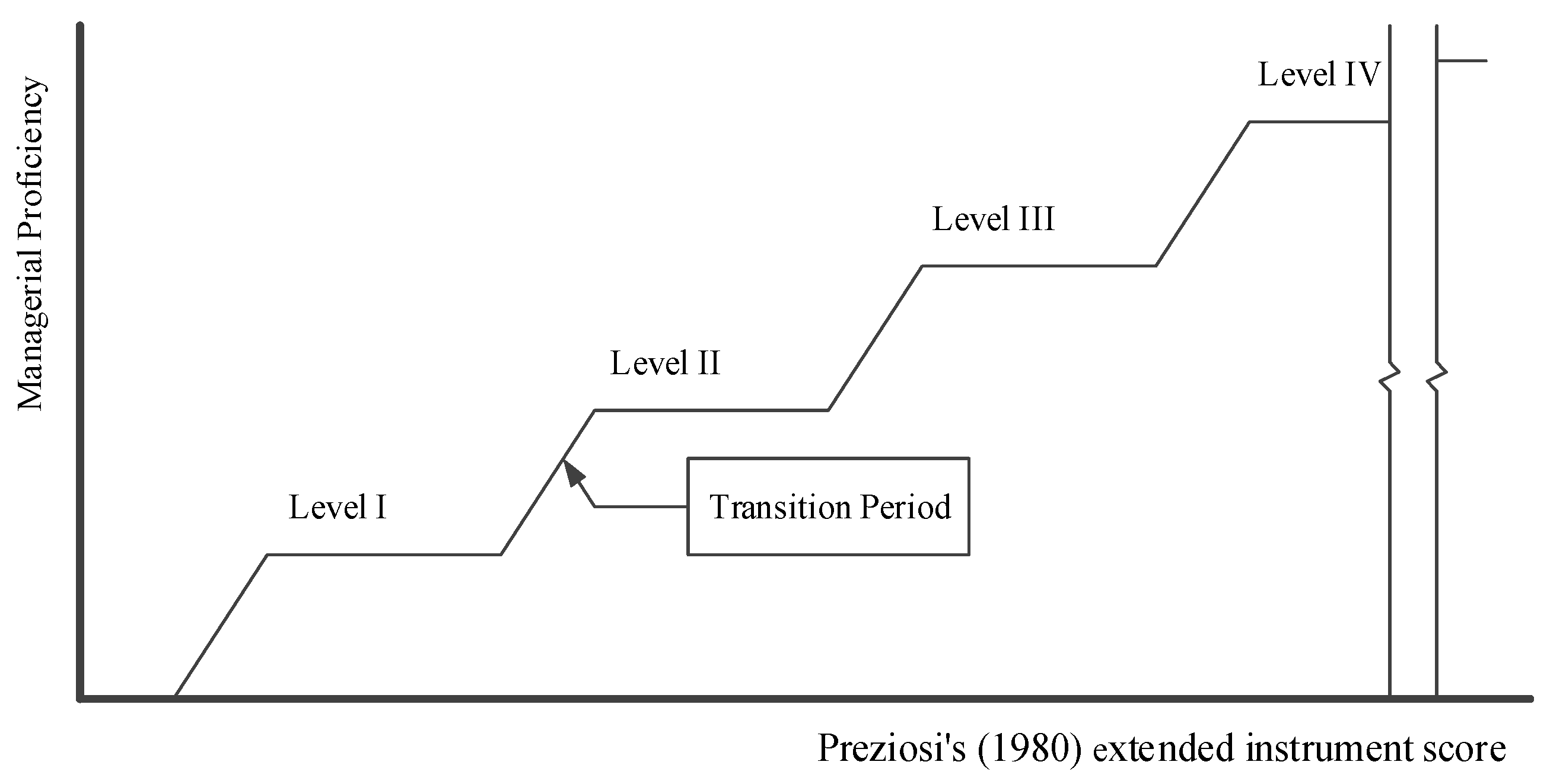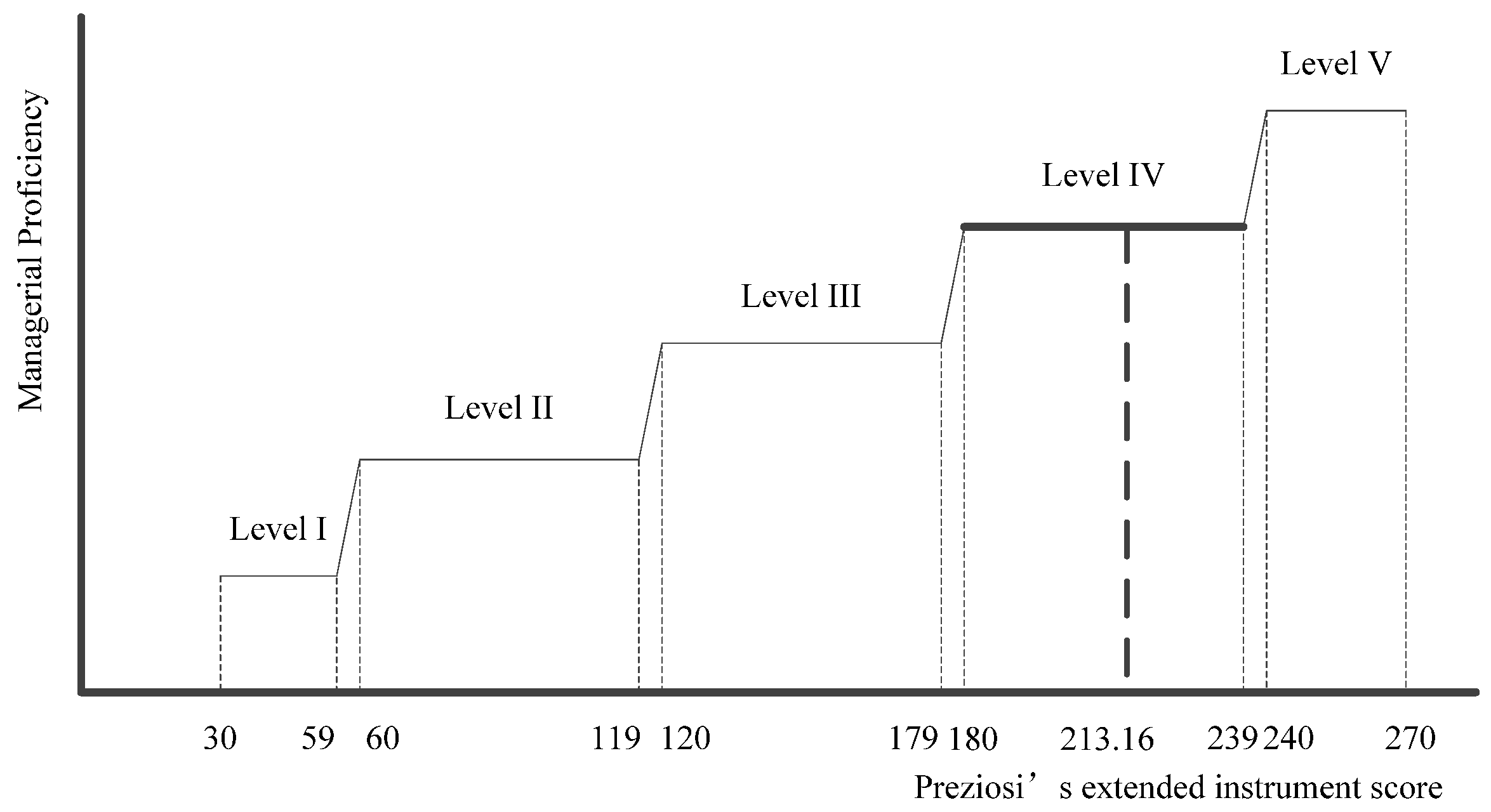4.1. Data Collection
This data collected for this study was provided by the authors’ consultation program and supported by PetroChina South Sulige Operating Company (PSSOC), located in Shaanxi province in China, which is a local large company of PetroChina’s Changqing Oilfield Company. This company provides exploration and production of crude oil and natural gas. PetroChina Changqing Oilfield Company operates as a subsidiary of PetroChina Company Limited (PetroChina). As one of PetroChina’s major oilfields, PetroChina Changqing Oilfield company covers five provinces in China, namely, Shaanxi, Gansu, Ningxia, Inner Mongolia, and Shanxi, and plays a pivotal role of supplying natural gas to more than ten big and medium size cities, including Beijing, Tianjin, and Shijiazhuang. PetroChina is the largest oil and gas producer and distributor, playing a dominant role in the oil and gas industry in China. PSSOC is a joint venture project between China National Petroleum Corporation and France’s Total SA, in Northern Inner Mongolia. It started operations in 2012, and about 450 wells were drilled before production of the field could reach 3 billion cubic meters per year. China National Petroleum Corporation owns 51 percent of the project and will be the operator, while total SA holds the remaining 49 percent and will provide technology and management. This joint petro project is also the first time a Chinese company acts as the operator in a joint venture project in the petroleum field.
In order to investigate the internal motivational factors and evaluate the evolutionary growth level for PSSOC, a quantitative approach has been utilized. This approach addresses the research objectives through creation of concrete numerical descriptions of employee perceptions on a number of constructs by the adoption of Preziosi’s organizational diagnosis questionnaire [
42]. Data collection was conducted through the exhaust questionnaire surveys in PSSOC. The survey method was selected because there was little control over behavioral events, and the focus was to identify and develop a contemporary phenomenon within a real life context. Quantitative data collected from the distributed questionnaires were analyzed utilizing the SPSS 22 software. Cronbach’s alpha test was conducted to assess reliability of the scale items [
70]. Descriptive statistics described and summarized profiles of the entire sample.
The questionnaire issue and collection is shown in
Table 3.
The instrument descriptive statistics of seven subsystems is shown in
Table 4.
According to
Table 4, by the consideration of Preziosi’s instrument data interpretation [
42], the simplest diagnosis would be to assess the amount of variance for each of the five variables in relation to a score of 5, which is the neutral point. Scores below 5 would indicate that there is a problem with the respective organizational functions. The closer the score moves to 1, the more severe the respective problem. Scores above 5 would indicate that there is no problem, and a score of 9 would indicate optimum functioning of the respective organizational function. Thus, the mean score of Rewards (6.80) and Attitude Toward Change (6.76) were a little further away from the score of 9 than the other six subsystems, which indicated a potential problem area in the PSSOC sample. Additionally, the average of Leadership (7.43) was the maximum, which indicates the optimum organizational functioning at the current level.
At the same time, according to the statistics principle [
71], standard deviation referred to the variation degree between the samples’ observed values, which indicated the observed fluctuations. The standard deviation in
Table 4 shows that all standard deviations are below 2 [
71,
72], which indicates that PSSOC employee attitude to organizational function was at a relatively consistent level and not in a state of fluctuation. The standard deviation describes the degree of variation between the values observed in the sample, indicating the size of the observed fluctuations of less than 2 for the attitude of employee, which means that the observations were consistent and centered around this dimension.
4.2. Data Quality
The reliability analysis and validity for each of the composite constructs of the questionnaires of this research were examined to test data quality [
71,
72,
73]. Reliability of the scale examines its internal consistency by calculating Cronbach’s alpha. Therefore, to explore the reliability of the constructs in order to design good scales for measurement, data were analyzed using SPSS 22.0 software (SPSS 22.0.0.1, International Business Machines Corporation, Beijing, China). The processes are shown in
Tables S1–S4 in the supplement material.
Additionally, to estimate the reliability of the items for each construct, internal consistency methods include the value of item-to-total correlation and Cronbach’s alpha value [
71,
74]. A minimum value of item-to-total correlation values should be greater than 0.40, and item-to-total correlation values in each construct at the 0.05 level are of reliable significance [
71,
75].
Hence, as unreliability in these items would mean that they could not be used in any future examinations, the item-to-total correlations and Cronbach’s alpha values for items within the seven components have been analyzed (see
Table 5).
All internal consistency reliability based on Cronbach’s alpha for measurement items was found to be greater than 0.7 and considered to be good and acceptable, indicating a high degree of internal consistency [
71,
74,
75].
4.5. Discussion
In order to achieve sustainable organizational change, PSSOC should recognize the importance of the four subsystems and adopt necessary countermeasures to settle the corresponding primary internal factors at the current level, including (a) Purpose; (b) Structure; (c) Leadership and (d) Helpful Mechanisms.
(A) Purpose: PSSOC should create a clear organizational purpose (PUR-2 in
Table 5) and support the changes necessary for reaching desired future outcomes (PUR-3 in
Table 5). Organizations need to share their organizational purpose to move toward the desired direction and sustain the adaptation process to create a future for the organization. If employees are not absolutely sure about their organization’s purpose, they will make their own presumptions and projections, which often lead to wrong actions. The shared organizational purpose creates consistent attitudes among employees which will guide their decisions about their cognitive level of support for needed change initiatives [
76]. Therefore, the organizational purpose should be salient to all members in the organization, with members understanding that a clear organizational purpose has been articulated and that the leadership of the organization shares that purpose. Additionally, a company should build an environment where all employees fully understand the organizational purpose. Leadership will have to clarify what the organizational purpose is with regard to each employee’s position, and ensure that the resources to execute the organizational purpose are in place to accomplish the desired organizational goal.
(B) Structure: Weisbord [
26] stated that structure refers to a fit between the purpose and the internal structure of an organization. In other words, internal structure refers to the degree of authority in an organization and how work is being apportioned [
77]. This structure could then provide specific avenues to implement internal change processes in particular situations, considering management support and time constraints [
12].
For PSSOC, avoiding the influence factor (STR-5 in
Table 5) could be a central problem to the sustainability of organizational change. The authors therefore suggested that PSSOC should (1) adjust the department structure and the corresponding labor division; (2) build communication mechanisms; and (3) allocate the scopes and responsibilities of various departments in a way to avoid overlapping and therefore enhance the organization’s departmental efficiencies. At the same time, in order to drive structural change, the organization may implement pilot projects, experimental units, technology supports, and special task forces. Once a clear direction of how to implement change is recognized, a need to design specifications for departmental change may arise and be directed to specify those needs and implement action plans.
(C) Leadership: Weisbord [
26] proposed that organizational leadership should focus on whether leaders define purposes, whether they embody purposes in their programs, and what the normative style of leadership is. Research has shown that effective leadership is the most important factor for successful change, and organizational success or failure depends on the ability of its leaders [
78,
79,
80]. Whenever the challenges of managing organizational change for sustainability is involved, effective leaders who are competent to embrace and facilitate change are required to influence their subordinates [
81].
As for the influence factor (LEA-3 in
Table 5) of leadership in PSSOC, effective leaders should influence the way their subordinates think and introduce new processes into the organization by influencing the understanding of current structures and shaping values to facilitate internal comprehension of the need for organizational growth [
82,
83]. As such, the following activities could be implemented: (1) in-depth understanding of a department’s current situation; (2) fulfilling employee’s needs; (3) strengthening communication and interaction among staff in the within and among departments; and (4) motivating staff to develop a passion toward work goal achievements by participating in decision processes.
(D) Helpful Mechanisms: Weisbord [
26] proposed that helpful mechanisms mainly referred to whether these mechanisms help or hinder the accomplishment of organizational objectives. Effective sustainable change requires mechanisms that allocate sufficient resources to support a process [
41,
81,
84]. This include team support policies and functional support for projects, which are critical to successfully managing change within organizations and to track work systems and identify problem areas.
As for the influence factors (HM-4 and HM-1 in
Table 5) of helpful mechanisms in PSSOC, a key task for leaders is not only to allow the clear goal for the personal and group implementation, but to find a balance and collaboration between the resources deployed in different departments. PSSOC also needs to overcome resistance to sustainable growth by sustaining the goal and confidence of staff and by ensuring that their organization has sufficient resources to support such change.
Helpful mechanisms should support the implementation of organizational change. When employees feel that they have helpful mechanisms, such as resource support for change, there is an increased likelihood that organizational achievements will increase and that sustainable change implementation will be realized [
22,
81,
85,
86,
87]. Employees’ perceptions of the extent to which their organization has sufficient helpful mechanisms to achieve change (e.g., readily available finance, communication technologies, flexible systems, and responsive training and education), and the degree to which they can actively and genuinely participate in the process, are significant factors in accomplishing successful change [
22,
81,
85,
86,
87].
Last but not least, the above statement was the central problem areas for PSSOC, and it was not surprising that sustainable organizational change was a system change that needed the synergy of seven subsystems in the WSBGMM framework. This system also implies not only that sufficient support for targeting a problem area is needed to provide implementing agencies to ensure effective change [
34,
41], but also that time was a necessary resource to successfully transform an entire system [
87,
88], which allowed employees to participate in the change process and successfully bring their activities to the process of the whole WSBGMM system.












